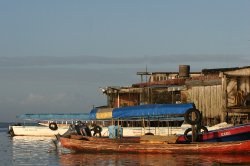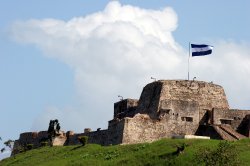 Minutes after dropping our lines into the muddy river, Tucsonan Bob Greenberg hooked into a two hundred pound monster. Exploding out of the water, the tarpon ran and jumped as night fell. Extremely fit, Bob struggled to even move the fish. As the sun set over the jungle canopy, we had visions of Hemingway’s “The Old Man and the Sea”, when the Cuban “viejo” fought the fish throughout the night. Bob brought the fish to the boat time and again, only to have it make another long run.
Minutes after dropping our lines into the muddy river, Tucsonan Bob Greenberg hooked into a two hundred pound monster. Exploding out of the water, the tarpon ran and jumped as night fell. Extremely fit, Bob struggled to even move the fish. As the sun set over the jungle canopy, we had visions of Hemingway’s “The Old Man and the Sea”, when the Cuban “viejo” fought the fish throughout the night. Bob brought the fish to the boat time and again, only to have it make another long run.
Each time we were unsuccessful in trying to release the fish. Using a weak flash light, it was challenging to follow the movement of the fish. Our guide Chili, leaned over the side of the panga in an effort to catch the leader. Each of us readied a gaff and pair of long-nosed pliers for his use.
After a two and a half hour fight, Bob finally succeeded in releasing the tarpon into the darkness of the night. We were unable to see the silver king’s beauty, its length or girth. Relishing the experience, we motored downriver under a crystal clear star-studded night. Two hundred pounds of magnificent tarpon was hard to believe, but it was true.
Our host, La Esquina del Lago fishing lodge owner Philippe Tisseaux had told us, “This is extreme fishing. You’ll be fighting tarpon deep in the heart of the Nicaraguan jungle. Two hundred pounders will be jumping within sight of your twenty three foot panga, but you’ll need skill and luck to catch them.” We had just become believers.
Philippe thinks Río San Juan tarpon fishing is the ultimate challenge, but one for experienced and patient anglers.” Or, as Brian O’ Connor of Corolla, North Carolina more pointedly argued, “it’s a knock-down dragged-out brawl with the tarpon controlling you.”
Pioneering in San Carlos in 2003, Philippe bought a corner of land edged by Lake Nicaragua, Río San Juan, and Río Frio and built La Esquina del Lago, which translates to “corner of the lake.”
Most of the fishing is done in Reserva de Biosfero Río San Juan, a lush rain forest of towering trees, winding vines, exotic shore birds, monkeys, sloths, deer, nutria, and other jungle wildlife concealed by the canopy.
 Río San Juan is a birder’s paradise. White egrets, roseate spoonbills, tiger and blue heron, cormorants, anhinga, jacanas are just a few species that territorially stalk bait-size fish along the river’s bank.
Río San Juan is a birder’s paradise. White egrets, roseate spoonbills, tiger and blue heron, cormorants, anhinga, jacanas are just a few species that territorially stalk bait-size fish along the river’s bank.
The journey begins in San Carlos, a non-descript village that once served as a Spanish fortress. After landing on a 1500-foot dirt and grass strip in San Carlos, the transfer from a taxi to a panga to Philippe’s Lodge takes only minutes.
It was late in the afternoon when we arrived at La Esquina del Lago. A puff of volcanic ash expelled from Rincon de la Viera rise over Lake Nicaragua’s horizon then dissolves into a beautiful orange-colored sunset. In the distance, approximately thirty one miles, Costa Rica’s forested mountains loom on the horizon.
Sipping Nicaragua’s finest, Flora de Cana Grand Reserve rum, we sat on the mahogany porch in rocking chairs watching fire flies flash among the trees as we shared fish tales and our eager anticipation. Night time in the jungle is a symphonic cacophony. The repetitive shrill of an unidentified jungle bird screeches a cry that sounds like “where are you?” Different species of frogs and toads croak and gargle. Rain beats on the corrugated roof. Howler monkeys grumble. Dogs bark.
Río San Juan flows southerly from Lake Nicaragua in San Carlos pass the villages of Sabalos and El Castillo, where picturesque ruins of a Spanish fortress tower on a hillside above a wide stretch of rapids. This natural barrier stopped marauding pirates, and in the 1850’s gold rushers bushwhacked around them on their way to California. The rapids stop us as well.
Men in small wooden canoes fish the banks for bass-like guapote. They sell their catch to locals or the few scattered restaurants along the Río. Women wash clothes and dishes in the river. Stilted houses, without electricity, are scattered. The friendly Nicas wave as we pass. Industrious, subsistence farmers, they raise livestock and grow produce. Locals flagged down long boats, operating like ferries, to carry them between destinations.
Having told us to bring enough clothes for “one or two nights” we fish our way to Sabalos Lodge, a two hour non-stop motor. The wood planked hotel has small rooms opening along an open corridor above the river. Like La Esquina del Lago, Sabalos Lodge has no hot water for showering, but the small rooms include a fan. Regardless, we are happy to rinse off the grime of a day’s sweat and sun tan lotion. And, we stay for three nights.
My adrenaline races when the first tarpon strikes my rod. It’s a big one, a six-foot silver king weighing approximately 155 pounds. Hooked in the cheek, it’s a two hour battle to the release. Husband David Peachin hooks into a tarpon and releases a gar. Bob catches a snook, which Sabalos Lodge grills, providing us a delicious lunch. Nicaragua is not a foodie’s destination, so we relish every bite.
 During the night rain pounds the steel corrugated roof. Río San Juan, measuring as much as 200 annual inches of rain, is one of the wettest regions in the world. Whenever a torrential downpour soaks us, it’s cooling, and preferable to the blazing heat of the equatorial sun.
During the night rain pounds the steel corrugated roof. Río San Juan, measuring as much as 200 annual inches of rain, is one of the wettest regions in the world. Whenever a torrential downpour soaks us, it’s cooling, and preferable to the blazing heat of the equatorial sun.
Patience can be spending a day or more waiting for a strike by a “big one” in Río San Juan. When it happens, Philippe’s theory of fighting “finesse” comes into play. “Point the rod toward the fish to allow the tarpon to run freely. When it explodes wildly into the air to toss the hook, simply turn your wrist to twist the rod away from the fish. That prevents the silver king from swallowing the lure. Whenever tarpon jump, lower the rod toward the water.
Along the river, Median and her 82-year-old husband Enrique Montian have a compound, connected by a rickety boardwalk that crosses a swamp-like area. Multiple buildings house their twenty four children. It is obvious that the homestead, built by Enrigue, expanded with each addition to his family.
Phillipe has an arrangement for his anglers to stop there for lunch. Seeing some passing fisherman in a canoe, we buy guapote from their iced container. Median cooks it up for us on her wood-burning stove rather than serving us chicken. The lunch including beans, rice, and plantains costs $2.00 a person.
Not too long ago, residents along the Rio San Juan were got in the middle of the war between the Contras and Sandinistas. Many lost their lives and families. As the years passed, only the tarpon lived peacefully, and grew bigger and larger.
Now the Río San Juan is open to tourism. There is little tourist infrastructure and fewer amenities. But, if you are looking for a real fishing challenge, hook into one of those hefty tarpons.
Contact: Philippe Tisseaux at S.C.S San Carlos Sport Fishing to fish La Esquina del Lago, tarponsnook@hotmail.com or go to
Mary L. Peachin is a native Tucsonan. She is author of The Complete Idiot’s Guide to Sharks, Scuba Caribbean, and Sport Fishing in the Caribbean (University Press Florida, 2010). An award winning travel writer and photographer, you can read her adventures at test.peachin.com or e-mail her at mary@peachin.com
